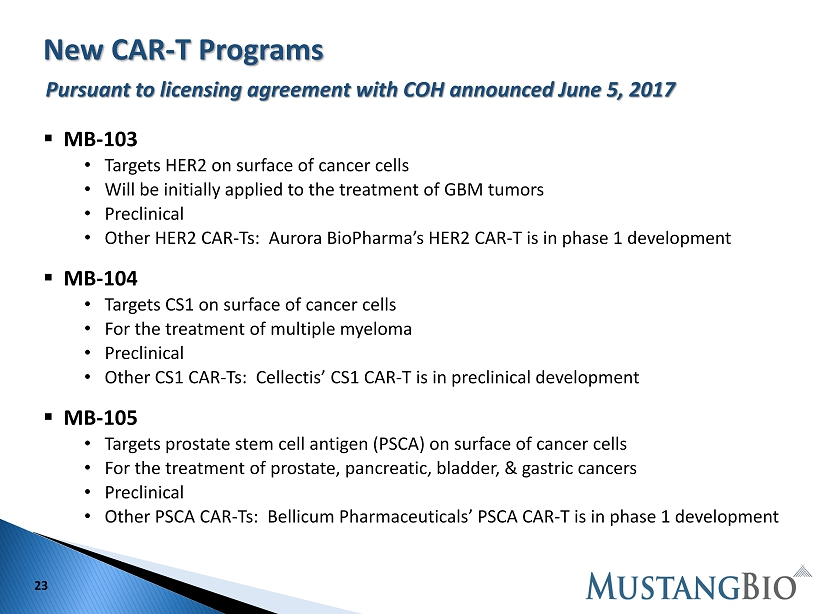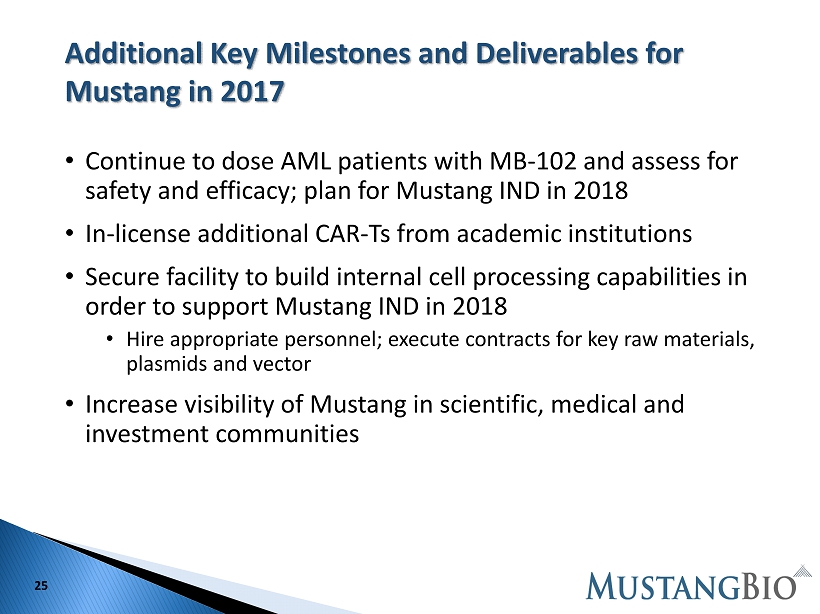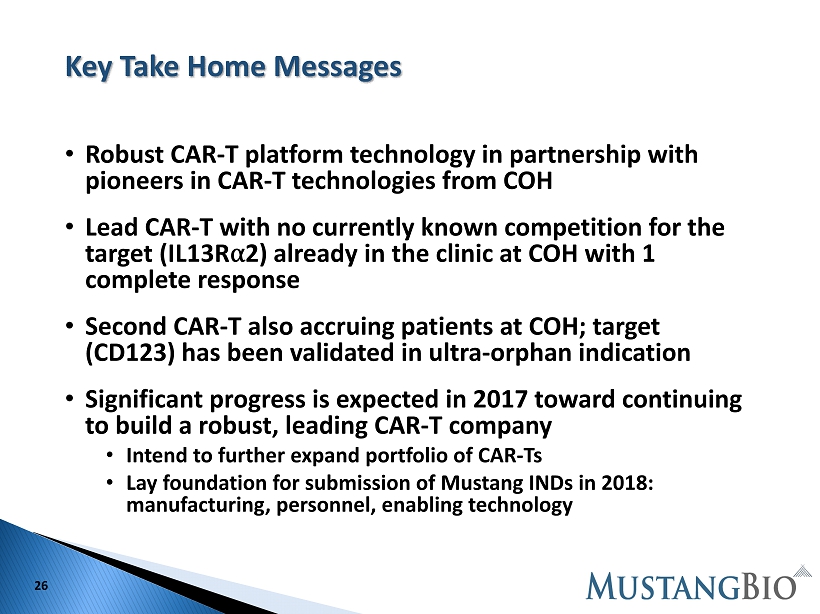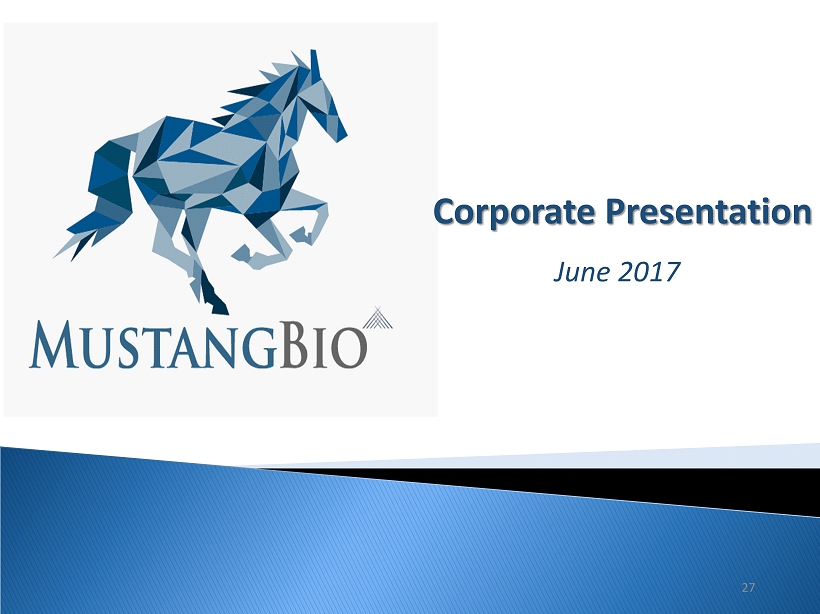
Exhibit 99.1

Corporate Presentation June 2017

Forward Looking Safe Harbor Statement This presentation contains forward - looking statements within the meaning of the Private Securities Litigation Reform Act of 1995 . These statements are often, but not always, made through the use of words or phrases such as “anticipates”, expects”, plans”, believes”, “intends”, and similar words or phrases . Such statements involve risks and uncertainties that could cause Mustang Bio’s actual results to differ materially from the anticipated results and expectations expressed in these forward - looking statements . These statements are only predictions based on current information and expectations and involve a number of risks and uncertainties . Actual events or results may differ materially from those projected in any such statements due to various factors, including the risks and uncertainties inherent in clinical trials, drug development, and commercialization . You are cautioned not to place undue reliance on these forward - looking statements, which speak only as of the date hereof . All forward - looking statements are qualified in their entirety by this cautionary statement and Mustang Bio undertakes no obligation to update these statements, except as required by law . 2

Corporate Overview • Founded by Fortress Biotech in 2015 • Chimeric Antigen Receptor (CAR) T Cell technology from City of Hope (COH) • Based on the research of Stephen Forman and Christine Brown, pioneers of CAR - T technology • First two CAR - Ts entered the clinic in 2015 and 2016 • Research collaboration between Mustang and COH to • Identify additional CAR - T clinical candidates • Improve the efficacy of collaboration CAR - T clinical candidates 3

Mission Statement To provide long - term clinical remissions for patients with aggressive forms of cancer by leveraging best - in - class science to create novel CAR - T therapies. 4

Publicly Traded CAR - T Companies 5 Company Name (Ticker) Market Cap (6/1/2017) Kite Pharma (KITE) ~$4.2B Juno Therapeutics (JUNO) ~$2.6B Ziopharm (ZIOP) ~$0.9B Cellectis (CLLS) ~$0.8B

What is a CAR - T? Chimeric Antigen Receptor - T Cell The CAR recognizes targets on the surface of the malignant cell to direct and activate T - cells to destroy the tumor 6 Transmembrane domain CAR Single - chain variable fragment ( scFv ) Co - stimulation domain (4 - 1BB or CD28) CD3 ζ signaling domain Antibody fragment that identifies and targets tumors (e.g. CD19, CD20 on the surface of the malignant cells) Function: Links co - stimulation domain to the antibody fragment (can affect efficacy) Strengthens patient - derived T - cell signaling and persistence, enhances potency Activates the cytotoxic patient - derived T - cell to which the CAR is attached

How is a CAR - T made? 7 CAR - T Blood sample obtained via apheresis T - cells extracted T - cells engineered in cell - processing facility T - cells administered back to patient Total time from apheresis to infusion: ~2 - 4 weeks

Lead CAR - T Programs • MB - 101 • Targets IL13R ⍺ 2 on surface of cancer cells • For the treatment of glioblastoma multiforme (GBM) tumors • Phase 1 ongoing • MB - 102 • Targets CD123 on surface of cancer cells • For the treatment of AML (acute myeloid leukemia) and BPDCN ( blastic plasmacytoid dendritic cell neoplasm) • Phase 1 ongoing 8 All trials currently being conducted under COH IND

MB - 101: IL113R ⍺ 2 is an Ideal Target for GBM 9 • Jonnalagadda et al. Mol Therapy; 2015 • Wang et al. Immunotherapy; 2011 • Brown et al. Manuscript in preparation Target Antigen Normal Brain GBM T - Cells TNFR + / - +++ +++ HER 2 - +++ - EGFR ++ ++++ - EGFRvIII - ++++ (<30%) - IL13R ⍺ 2 - ++++ (>90%) -

MB - 101 CAR - T is More Potent than 1st Generation IL13 - Targeted CAR - T 10 D7 D1 3 D1 6 D2 0 D 2 7 1.0 M 0.3 M 0.1 M Mock Tcm T umor O nly 1.0 M 0.3 M 0.1 M 1 st gen IL13R ⍺ 2 CAR - T 2 nd gen IL13R ⍺ 2 CAR - T 1 st gen IL13R ⍺ 2 CAR - T 2 nd gen IL13R ⍺ 2 CAR - T

Phase I Clinical Trial with MB - 101 is Ongoing 11 Patient P opu l at i on Planned E n r o ll m e nt Study Objectives Relapsed/Refractory GBM • Arm 1: R esectable • Arm 2: Non - resectable 1 2/arm • Assess feasibility and safety • Determine MTD

Resection Arm – ICT Treatment Summary 12 Patient # Tx Arm / Dose IL13R ⍺ 2 IHC Manuf. CAR - T Cells Treatment Dose Notes UPN097 Resection / Dose 1 110 64% CAR 16 days Cycles 1, 2: 2M, 10M PD; Off - study due to rapid tumor progression UPN109 Resection / Dose 1 80 64% CAR 18 days Cycles 1, 2, 3 (ICT): 2M, 10M, 10M Cycles 4, 5, 6 (ICT): 10M, 10M, 10M Cycles 1, 2, 3 (ICV): 2M, 10M, 10M Cycles 4, 5 (ICV) : 10M, 10M Cycles 6 - 9 (ICV): 10M CR; Treatment ongoing (7 months) UPN117 Resection / Dose 1 200+ 60% CAR 15 days Cycles 1, 2, 3: 2M, 10M, 10M PD; Off - study due to rapid tumor progression UPN122 Resection / Dose 1 150+ 95% CAR 14 days Cycles 1, 2, 3: 2M, 10M, 10M Cycles 4, 5, 6: 10M, 10M, 10M SD* (6 cycles) UPN125 Resection / Dose 2 200+ 73.5% CAR 15 days Cycles 1, 2, 3: 10M, 50M, 50M Cycles 4, 5, 6: 50M, 50M, 50M SD* (6 cycles) UPN131 Resection / Dose 2 130+ 81.3% CAR 14 days Cycles 1, 2: 10M, 50M*, 50M SD* (6 cycles) Dose Schedule 1: Well – tolerated in all patients treated No grade 3 or higher toxicities No cytokine release syndrome or neurotoxicity Grade ≤2 fevers, headaches, myalgia, chills ICT = intracavitary (i.e., into the cavity in the brain created by resection of the tumor) ICV = intracerebroventricular (i.e., into the ventricular system that bathes the brain and spinal cord) *Preliminary data, currently under QA review

Progression of New Tumors Distant from CAR - T Cell Infusion Site 13 IL13R ⍺ 2 CAR - T cell infusion First dose of “systemic” therapy Days Post - Enrollment Max Lesion Area (mm 2 ) Cycles 1 - 6 (ICT) Cycles 7 - 11 (ICV) UPN 109 • 50 yr ; male • GBM – Primary Diagnosis • IDH1 wt ; MGMT - hypomethylated • SOC therapy: surgery, radiation, temozolamide , Novacure device (i.e. tumor treating fields) • Recurrent IL13R ⍺ 2+ GBM displayed poor prognostic features • Multifocal • Highly proliferative • Treatment – IL13R ⍺ 2 CAR - T cells • 6 intracavitary infusions (ICT) • 5 intracerebroventricular infusions (ICV)

Regression of Recurrent Multifocal Glioblastoma After Intraventricular Delivery of IL13R ⍺ 2 - Targeted CAR - T Cells 14 Sagittal MRI (top) and PET (bottom) of the brain Axial MRI of the brain All metastatic tumors in the spine were completely eliminated Maximum lesion area for non - resected tumors 4 through 8 with their respective decreases over time • Clinical response was sustained for 7.5 months after the initiation of CAR T - cell therapy, and none of these initial tumors recurred • These results show that treatment with the CAR - T resulted in a complete response Source: The New England Journal of Medicine . 2016;375:2561 - 9.

GBM is a Significant Unmet Medical Need • Glioblastoma multiforme (GBM) is the most common primary malignant brain tumor • GBM is also the most aggressive form of brain tumor, and is associated with extremely poor prognosis and survival • Median overall survival from diagnosis is approximately 15 months • 5 year survival of only 5% • ~30,000 newly diagnosed cases of GBM annually in the US, Japan and five major European markets 15

Competitive Therapies in Development for GBM 16 Drug Name Company Description Target Clinical Stage AU105 Aurora BioPharma AU105: Bispecific anti - HER2/anti - CMV pp65 antigen HER2 and CMV pp65 antigen Phase I CART - EGFRvIII NIH Anti - EGFRvIII CART EGFR Phase I CART - EGFRvIII University of Pennsylvania Anti - EGFRvIII CART EGFR Phase I CART - EGFRvIII Duke University Anti - EGFRvIII CART EGFR Phase I EGFRvIII Kite Pharma Anti - EGFRvIII CART EGFR Preclinical UCART - EGFRvIII Cellectis Anti - EGFRvIII “universal CAR” through expression on allogeneic T - cells EGFR Discovery

MB - 102 CAR - T Targeting CD123 Expressing Tumors • CD123* is expressed on cells of myeloid lineage and is overexpressed on AML, ALL and BPDCN • Human proof - of - principle with fusion toxin directed at target on BPDCN cells • Limited CAR - T competition for this target (Novartis, Juno and Kite are not in clinic) *Also known as IL - 3R ⍺ 17 • Wang et al. 2011 Blood • Mardiros et al. 2013 Blood • Jonnalagadda et al. 2014 Mol Ther

MB - 102 (CD123) – Antitumor Activity Against Human Acute Myeloid Leukemia 18 Mardiros et.al. Blood . 2013;122:3138 - 3148. CD123 CARs

Phase I Clinical Trial with MB - 102 is Open and Recruiting Patients 19 Patient Population Planned Enrollment Study Objectives Refractory / Relapsed AML 18 Assess the feasibility / safety and determine MTD of single infusion

AML is a Significant Unmet Medical Need • Acute myeloid leukemia is the most common acute leukemia in adults • Approximately 30,000 newly diagnosed cases of AML per year in the US, Japan and five major European markets • Overall five - year survival rate in the US is ~25% 20

Competitive Landscape for CD123 Targeted Therapies 21 Drug Name Company Drug Description Targets Clinical CART - CD33 CD123 Theravectys (China) CAR CD33, CD123 Phase I/II SL - 401 Stemline IL3 fusion toxin CD123 Phase I/II CSL - 360/362 CSL MAb CD123 Phase I GD006 MacroGenics Bi - specific antibody to CD123 and CD3 CD3, CD123 Phase I SGN - CD123A Seattle Genetics Antibody - drug conjugate CD123 Phase I UCART123 Cellectis Allogeneic T - cell CAR CD123 Phase I planned

Ultra – Orphan Opportunity: BPDCN • Blastic plasmacytoid dendritic cell neoplasm is a rare but aggressive blood cancer • Annual US incidence: <60 (similar or larger number in Europe) • No standard of care • Median overall survival: 9 – 12 months • Uniformly very high CD123 expression • Proof - of - Principle • IL - 3 target fusion protein • In a pilot trial, 7/9 BPDCN responded (5 CR, 2 PR) • Median duration of response: 5 months (1 - 24) 22

New CAR - T Programs ▪ MB - 103 • Targets HER2 on surface of cancer cells • Will be initially applied to the treatment of GBM tumors • Preclinical • Other HER2 CAR - Ts: Aurora BioPharma’s HER2 CAR - T is in phase 1 development ▪ MB - 104 • Targets CS1 on surface of cancer cells • For the treatment of multiple myeloma • Preclinical • Other CS1 CAR - Ts: Cellectis’ CS1 CAR - T is in preclinical development ▪ MB - 105 • Targets prostate stem cell antigen (PSCA) on surface of cancer cells • For the treatment of prostate, pancreatic, bladder, & gastric cancers • Preclinical • Other PSCA CAR - Ts: Bellicum Pharmaceuticals’ PSCA CAR - T is in phase 1 development 23 Pursuant to licensing agreement with COH announced June 5, 2017

Key Milestones and Deliverables for Mustang in 2017: GBM CAR - T • Amend GBM protocol to allow continued intracerebro - ventricular dosing with MB - 101 • Collect safety and efficacy data at COH • Conduct in - depth root - cause analysis for all suboptimal responses and assess how therapy might be improved • Explore creation of dual CAR - T construct to target both IL13R ⍺ 2 and HER2 • Explore other interventions that have been shown to improve the efficacy of CAR - T therapy in solid tumors (e.g., gene editing of PD - 1 on T - cells via CRISPR) • Plan for Mustang IND in 2018 24

Additional Key Milestones and Deliverables for Mustang in 2017 • Continue to dose AML patients with MB - 102 and assess for safety and efficacy; plan for Mustang IND in 2018 • In - license additional CAR - Ts from academic institutions • Secure facility to build internal cell processing capabilities in order to support Mustang IND in 2018 • Hire appropriate personnel; execute contracts for key raw materials, plasmids and vector • Increase visibility of Mustang in scientific, medical and investment communities 25

Key Take Home Messages • Robust CAR - T platform technology in partnership with pioneers in CAR - T technologies from COH • Lead CAR - T with no currently known competition for the target (IL13R ⍺ 2) already in the clinic at COH with 1 complete response • Second CAR - T also accruing patients at COH; target (CD123) has been validated in ultra - orphan indication • Significant progress is expected in 2017 toward continuing to build a robust, leading CAR - T company • Intend to further expand portfolio of CAR - Ts • Lay foundation for submission of Mustang INDs in 2018: manufacturing, personnel, enabling technology 26

Corporate Presentation June 2017 27